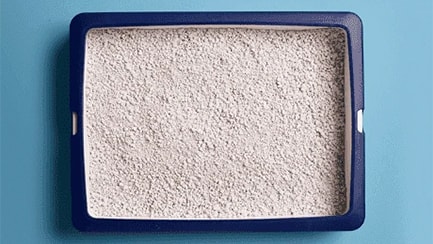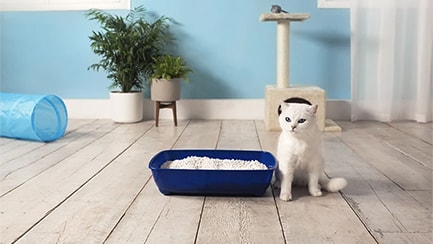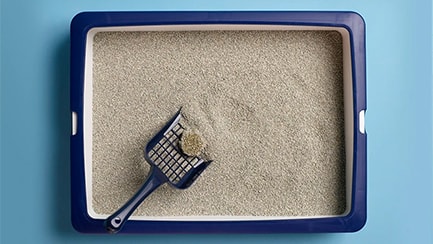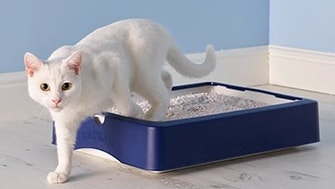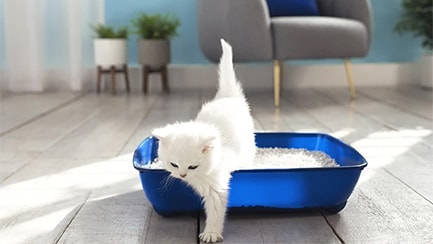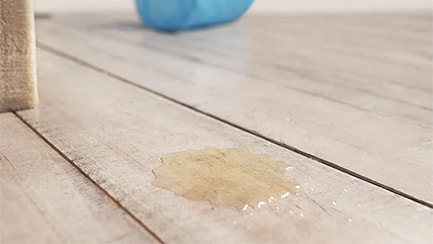FAQs
-
How can I litter train my kitten?
Most kittens will instinctively use a litter tray from a young age, particularly if they’ve seen their mum do it. (There are lots of really important reasons why kittens shouldn’t be taken from their mothers too early, and you can add this relatively minor one to that list.)
It’s important to choose a litter that’s safe for your kitten as, just like human babies, kittens tend to explore the world with their mouths. This means a non-clumping, natural litter that is less likely to be inhaled or ingested. We recommend you avoid clumping litters for your kitten as it’s more likely to clump in their tummies if they do eat it.
To train your kitten to be a litter box pro, place several litter trays around the house and make sure they’re easily accessible. Then, get into the routine of placing them in the litter box after mealtimes and naptimes (which is when they’re most likely to eliminate). If there are any accidents, don’t yell or punish your kitten as this will be counterproductive. Instead, place them in their litter tray to help them get the message for next time. Find out how to remove the cat wee smell if they do have an accident.
Why is it recommended that kittens use a litter tray and don’t go outside?
Things like traffic means the outside world can be dangerous for cats, especially kittens, and you certainly shouldn’t let your kitten go out before they have been dewormed and vaccinated. As elimination is part of marking territory, your kitten could be in contact with other cats’ waste. This won’t be a problem once your kitten’s immune defences are stronger but could cause a real issue if your kitten is allowed out too soon.
Instead, take the opportunity to get your kitten used to using the litter tray. Cats are territorial creatures and your kitten will want to find a specific place to eliminate.
What is the best litter for kittens?
For kittens, a coarse-grained non-clumping litter is recommended, such as Catsan™ Hygiene non-clumping litter. This is because it’s less likely to stick to their fur and be licked up by the kitten when they clean themselves.
Clumping litters are best avoided during the first 12 months of your kitten’s life as they may try to eat their litter. Clearly this is best avoided! However, if they do eat non-clumping litter, it’s unlikely to cause any problems and will just come out in the natural way.
Is it dangerous if my kitten eats litter?
It’s not unusual for kittens to eat their litter – and, for that matter, pretty much anything they can find!
For this reason, it’s important to choose a litter that’s unlikely to cause any serious issues if eaten. This means a non-clumping litter because clumps that form in the stomach can cause an intestinal blockage. You’ll also want a non-toxic type of litter made of natural substances, without any chemical odour-masking agents and fragrances. Catsan™ Hygiene non-clumping litter ticks all these boxes.
If your kitten does eat a large volume of litter (even if it’s the ‘right’ type) and you are in any way concerned about them, don’t hesitate to get them checked over by your vet. Eating litter can be a sign of malnourishment or other medical conditions.
What size litter tray is best for kittens?
The guideline for the size of a litter box is: one and a half times the length of the cat from its nose to the base of its tail. For your kitten, this will probably mean a box about 40 x 30cm. This will give your furry friend the opportunity to move around, dig and cover. Make sure the sides aren’t too high either. Your kitten needs to be able to get in and out easily.
Do you recommend clumping or non-clumping litter for kittens?
Until a kitten is 12 months old, we recommend non-clumping litter, such as such as Catsan™ Hygiene non-clumping litter. This is because clumping litters can be dangerous if they are eaten and this is something that young kittens are prone to do. Ingesting clumping litter can cause intestinal blockages which is an emergency and requires immediate vet attention.
Do you recommend coarse or fine-grained litter for kittens?
For kittens under 12 months old it best to opt for a coarse-grained, non-clumping litter. Fine granules are more likely to stick to their fur and get ingested when they clean themselves. It’s also not unusual for inquisitive kittens to eat their litter (or pretty much anything else!) and a coarse-grained, non-clumping litter is less likely to cause problems.
At what age can a kitten be separated from their mother? What is the mother’s role in litter behaviour?
Kittens should not be separated from their mothers until they are at least eight weeks old, and preferably 10 -12 weeks old.
When they are first born kittens can’t eliminate on their own and need their mums to stimulate excretion by licking them.
As kittens get older, their mums are pivotal in teaching their babies to use the litter box and most kittens are very happy to mimic what they see.
Do kittens pee more than adult cats?
It is true that a kitten’s metabolism is different to an adult cat’s (just like a human baby is very different to a human adult). However, if your kitten starts peeing a lot more than normal or having lots of accidents, it might be that they have a urinary tract problem or some other medical issue. If you’re at all concerned, talk to your vet.
Popular articles

